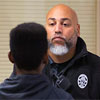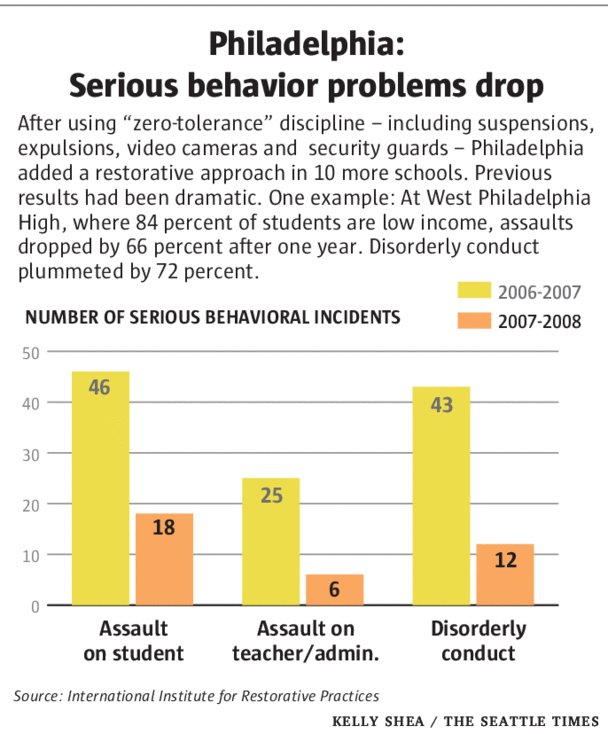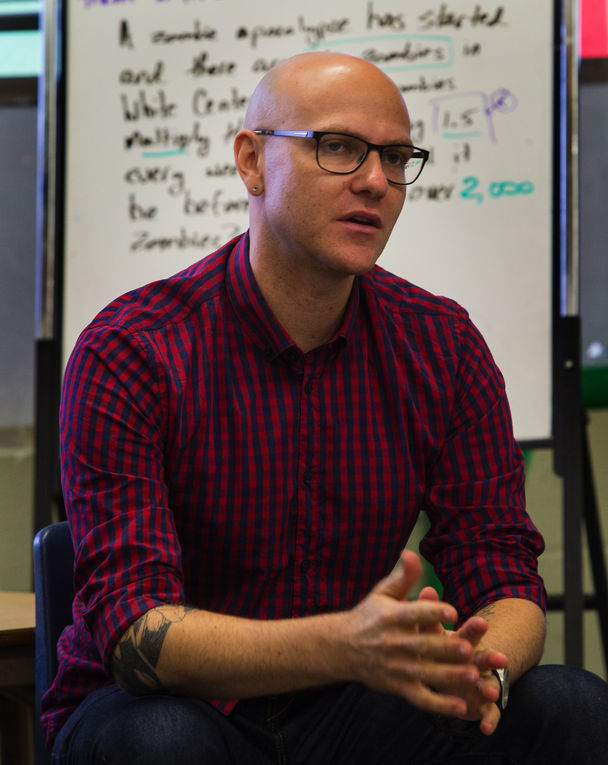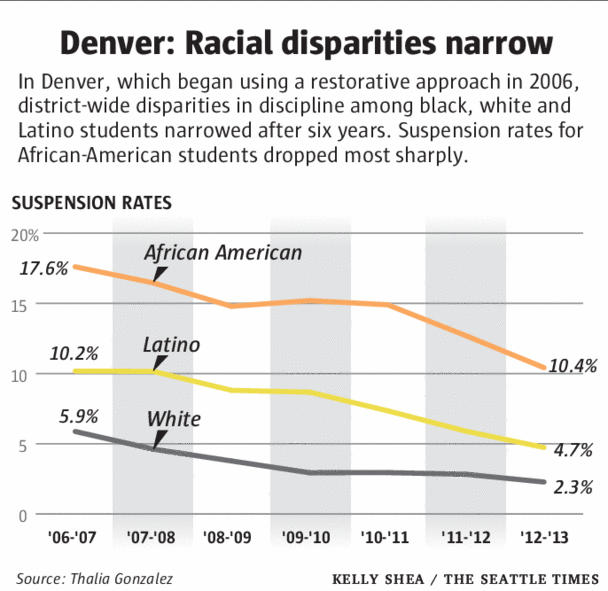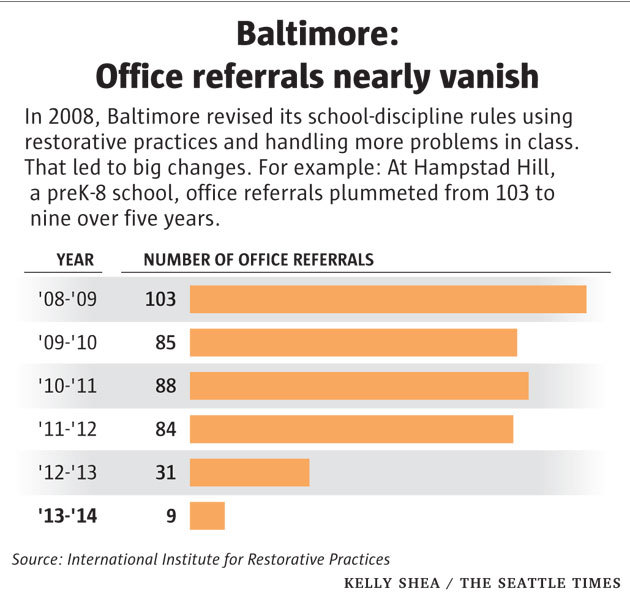Originally published January 24, 2015 at 9:03 PM | Page modified January 25, 2015 at 8:15 PM
In school discipline, intervention may work better than punishment
When tackling the topic of student discipline, some of the country’s toughest schools have done a turnaround. Instead of focusing on rules broken, they now ask kids to confront themselves. The result? Fewer suspensions and new perspective on the point of school itself.

Ellen M. Banner / The Seattle Times
Big Picture High School student Monae Trevino cries as she leads a group discussion about drug use, part of an alternative way of dealing with rule breaking. Offering support is school aide Peggy Yap Lee, at left, and Katie Nordman.
Seattle Times staff reporter
EDITOR’S NOTE
School districts all over the nation are rethinking the way they discipline students, especially for minor infractions. This Education Lab story is the second in an occasional series that examines why school districts are asking hard questions and what they’re doing to answer them.
About the series
Education Lab is a Seattle Times project that spotlights promising approaches to some of the most persistent challenges in public education. It is produced in partnership with the Solutions Journalism Network, a New York-based nonprofit that works to spread the practice of solutions-oriented journalism. Education Lab is funded by a grant from the Bill & Melinda Gates Foundation. Find out more.
Join the conversation
Stories in the series
Suspending kids doesn't fix bad behavior; what schools are trying instead
Published December 2014
It stands to reason: Kick troubled students out of school and they often come back even worse. The Kent School District is trying to tackle this national problem by overhauling the way it handles discipline. But its answers spark even more questions. Read the story →
UW gives future engineers a ‘redshirt season’
Published November 2014
In an idea borrowed from college athletics, the University of Washington boosts promising engineering students — many of them women and minorities — with an extra year of academic work. Read the story →
Does class size matter? Research reveals surprises
Published October 2014
The most obvious reason for why smaller classes work — that teachers give students better, more-tailored instruction — probably isn’t the reason why achievement goes up, studies have found. Read the story →
More about Education Lab
![]()
After a decade in classrooms, cheering on young people and believing in their progress, David Levine’s faith finally wilted. Three of his top students had walked into the front office at Big Picture High School reeking of marijuana at the precise moment that a donor stopped by with a $1,000 grant for new sound equipment.
Years ago, Levine might have recommended suspension for each young woman. Don’t do the crime if you can’t do the time, went his general thinking, right in line with prevailing American beliefs.
But discipline at Big Picture in the Highline School District has changed. In the process, its teachers have, too.
Rule breaking is now treated as harm done to a relationship — in this case, that between Levine and his students — rather than a reason to mete out punishment.
Instead of sending the three smokers home with a litany of their failings, Levine sat face to face with each, explaining what it felt like to have his trust violated. He read them testimony from other teachers, who spoke of their belief in the young women — how they had a chance to go to college, build a career, leave their difficult family lives behind.
By the end of her hourlong conference, 18-year-old Monae Trevino was weeping.
Afterward, she signed a contract setting out ways to make amends: by leading three student discussions on questions surrounding drug use, each of which meant significant research; reading two works of college-level literature and writing a related essay.
“It’s a lot harder than a regular suspension,” said Trevino, who had been kicked off campus multiple times at other, more conventional schools. “You can’t run from anything, and to have people talking good about you, telling you they’re truly disappointed — it hurts. It was kind of overwhelming, actually.”
Trevino’s conference was part of a practice known as restorative justice, and while rare in the Puget Sound region, the approach has been embraced elsewhere — not just at small schools like Big Picture in Burien, but across entire urban districts — as awareness grows that suspending kids often does more harm than good.
New research correlates typical zero-tolerance punishment with lower academic outcomes overall, even for kids who never step out of line. Further, the vast majority of suspensions are leveled against students of color, who come back to class more behind and less engaged than ever.
As described in an Education Lab story last month, Kent schools use in-house suspension — a de facto study hall — to keep kids connected to an academic atmosphere after low-level offenses like back talk or cutting class. But students still get tossed for insubordination.
Highline Public Schools uses “re-entry specialists” to discuss behavior with suspended youths before allowing them back in class.
But no school locally has gone as far as Big Picture, where discipline has become an avenue for students to face themselves and those they have harmed. In other words, educational.
“It confronts people with their choices, and that can get quite emotional,” said Levine. “But it also gives them a chance to creatively repair the harm. That never happens when you send a kid home.”
All of which might sound hopelessly idealistic were it not for the data.
San Francisco public schools began widespread use of restorative practices four years ago and has watched suspensions shrink by 49 percent.
At a middle-and-elementary school in Baltimore, Md., office referrals all but vanished in five years.
In Denver, academic achievement climbed steadily after the district switched to a restorative approach in 2006.
So far, such results — mirrored in San Antonio, Texas, Chicago and Philadelphia — count only as intriguing case studies. But they have prompted enough interest that randomized control trials, considered the gold standard for proof of success, are under way in several states.
Breaking the mold
Restorative justice, however, is no out-of-the-box program. It requires costly training, a significant investment of time and the willingness of teachers to cede some of their traditional authority.
Instead of being sent to the principal’s office, disruptive kids are scheduled for in-depth conferences like the one Trevino had with Levine. To keep everyone honest, a circle of advocates for each party watches, listening as both share their perspective on what happened and why.
“There’s definitely a new level of vulnerability for the teacher,” said Matthew Imperato, who coaches educators in San Francisco on using the approach. “They have to give up a little bit of their power.”
Restorative practices also reshape day-to-day dynamics. In an unruly math class, for example, the teacher might halt her lesson on graphs or tangents to ask why students are so distracted.
The strategy is an updated version of Maori tribal tradition that treats rule-breaking as damage to community bonds and seeks redress in the form of repair. (“Let shame be the punishment,” a Maori proverb says.) It has been used extensively in schools overseas.
But not until American educators began searching for ways to stem suspensions did restorative justice take hold in the U.S.
Last year, 3 million students were sent home, adding up to a staggering loss of instructional time just as government and business leaders are clamoring for better academic performance.
In San Francisco, Denver and Baltimore, that trend is seen as a nothing less than a crisis, and restorative justice is among the best hopes to change course.
“There’s promise of tremendous transformation,” said Anne Gregory, a school psychology professor at Rutgers University in New Jersey, who has researched the effects.
“The challenge is, this is more than just a workshop. It’s a philosophical change in approach. We have a very ingrained sense of the importance of punishment, and people think if you’re not excluding kids from school, you’re not holding them accountable.”
Locally, that tension is evident. At various schools individual educators have dabbled in restorative justice, though none — other than Big Picture — with the sustained effort and high-level backing required to see deep change.
“Without a shadow of doubt, it helped transform the culture,” said Brad Brown, former principal at First Creek Middle in Tacoma. But after he relocated to Kent, the school abandoned those practices.
“It can be very powerful, a truly educative tool,” said Catherine Brown, an assistant principal at Cleveland High in Seattle, where a number of teachers use the restorative approach, though in scattershot fashion, and without full-bore commitment from the school district.
Highline is the furthest along. As recently as five years ago, schools there were suspending kids by the thousands — “just throwing them away,” said Superintendent Susan Enfield.
Today, those numbers are dramatically reduced, and teachers are pushed to focus on students’ emotional state, rather than resorting immediately to removal.
“Restorative justice is the next level,” Enfield said. “We’re not there yet, but that’s the direction we’re heading because suspensions don’t work — we know that.”
Still, she has stopped short of mandating the practice in every school, unlike San Francisco, which did so last year with the support of its teachers union.
Time and money are probable factors.
San Francisco, which educates 57,000 students — comparable to Seattle — spends about $900,000 annually on training, coordinators and other expenses related to the restorative approach.
Even there, the effort is not unanimously embraced. Teachers pressured to cover vast amounts of material in preparation for state tests have been skeptical of the time required.
Similar concerns echo here. Yet at Big Picture, students do as well, or better, than the district average in reading, writing and science. And when judged on discipline, the school appears transformed.
Four years ago, before restorative justice became the norm, principal Loren Demeroutis assigned 700 days of suspension. This year, there have been eight.
“It’s true, teachers and principals don’t have time for any of the billion things we’re supposed to be doing, so you have to make choices,” he said. “In the long run these practices actually save time.”
It confronts people with their choices, and that can get quite emotional. But it also gives them a chance to creatively repair the harm. That never happens when you send a kid home.
- David Levine,
Teacher at Big Picture High School in Burien
You can’t run from anything, and to have people talking good about you, telling you they’re truly disappointed — it hurts.
- Monae Trevino,
18-year-old student disciplined at
Big Picture High School in Burien
Levine, the teacher who wrestled through conferences with Trevino and her friends, admits that initially, he considered restorative justice a joke. The son of two New York state correctional workers, he’d been raised with the notion of hard consequences for every infraction.
“I definitely get the need for punishment — that gut reaction — so this was a journey for me,” he said. “On the surface, it may seem like we’re making it easier for kids. But really, it’s a lot harder.”
Trevino’s jitters attest to that.
Several weeks after her restorative conference, she sat nervously waiting to begin the first of three contract-mandated discussions on drug use.
“I’m looking to you guys for help,” she said to a circle of classmates, after explaining her shame at squandering the goodwill of Big Picture’s teachers.
Twenty-five students and staff stared back.
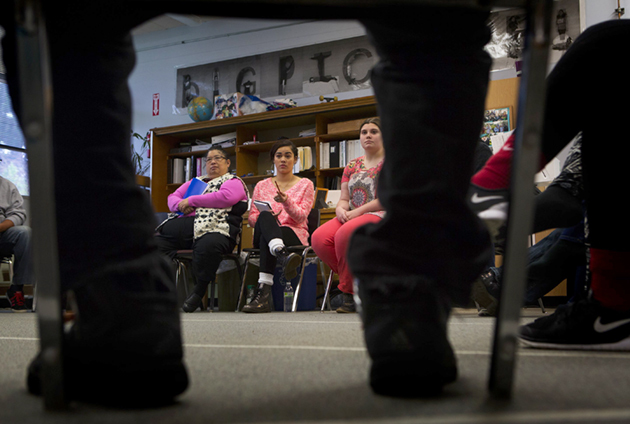
Ellen M. Banner / The Seattle Times
Instead of suspension, Monae Trevino, 18, center with pencil, had to lead a discussion about drug use. Big Picture High School in Burien is one of the few local schools using restorative justice instead of traditional discipline.
Balance of power
Aside from time demands, altering the standard adult-child power dynamic is a typical gripe when schools start using restorative discipline.
“Now you’re saying every decision I make, I have to go over with a kid? That’s a bit much,” complained a teacher in Oakland, Calif., which is also using the approach.
Enfield, who has vowed to abolish suspensions for disruptive behavior in Highline, encounters similar resistance.
“We’re making it harder on staff, I realize that,” she said. “But I taught high school for seven years and never suspended a kid. I broke up fights. I needed kids out of my face sometimes. But I was telling them, ‘When you make a bad decision, you don’t get the reward of not dealing with me.’ ”
For Trevino and her friends, the come-to-Jesus moment arrived when each had to acknowledge — in front of Levine and a circle of advocates — how her decision to use drugs affected the broader school community. It rattled one girl so much that she stormed out of the room.
(At a do-over conference several days later, the girl signed a promise to attend Al-Anon meetings.)
Levine and others at Big Picture say the incentive for muscling through such uncomfortable moments is the larger context. Nationally, students of color are suspended three times more often than whites — for the same offenses. Seattle has been under federal investigation for exactly this pattern since 2012.
But the talk-it-through approach fundamental to restorative justice appears to make a dent in those figures. In Denver, the discipline gap between black and white students narrowed by four percentage points after several years of using the practice. San Francisco is starting to see similar results.
“Why do you think more black students are getting kicked out than everybody else?” Imperato, the San Francisco coach, often asks his colleagues. “It can’t be that every black kid doesn’t know how to behave. It might be that we don’t understand their behavior as well as we need to, to teach them.”
Academic achievement
Those who have watched restorative justice at work often use terms like “culture change” or “paradigm shift.” Less discussed is the link to academic achievement and the way patterns set in school play out later through a host of societal ills.
But that connection was clear in Baltimore. In 2008, then-superintendent Andres Alonso told city leaders that crime and unemployment were both connected to school discipline.
“Reform discipline and I can guarantee you that we’ll start turning the dial on these other things,” he said, according to the recollection of Tisha Edwards, who was his assistant and eventually took the reins.
Seven years later, suspensions are down, achievement and graduation rates are up.
Not that Baltimore has utterly abandoned student removal. City schools use suspensions, though far less often.
“We were suspending kids as early as the third or sixth grade, and by the time that kid gets to ninth grade, you’ve got someone who’s illiterate,” said Edwards. “The data was very clear. It was just creating a pipeline for dropouts.”
Last winter, a delegation of Washington school advocates traveled to Baltimore to see for themselves. They were floored.
“I had no clue that there could be another way,” said Tre Maxie, a member of the State Board of Education. “We have some of the same challenges, but at a fraction of the depth. If they can get it right, we should be able to do even better.”
Levine, who once took suspensions for granted, has gone through a similar, and continuing, transformation.
A month ago he was flummoxed at the idea of writing a college recommendation for Trevino after she walked into school high. What could he say? How would he explain a punishment for drug use?
Now the idea inspires him. He’ll talk about Trevino’s ability to lead discussion groups, do research and read college-level literature — all of which came out of her restorative-justice contract.
“It’s a way,” he said, “to turn the most negative thing into possibly the most positive thing you’ve ever done in school.”
Claudia Rowe: crowe@seattletimes.com or 206-464-2531. On Twitter: @RoweReport
 Four weeks for 99 cents of unlimited digital access to The Seattle Times. Try it now!
Four weeks for 99 cents of unlimited digital access to The Seattle Times. Try it now!








